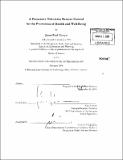| dc.contributor.advisor | Kent Larson. | en_US |
| dc.contributor.author | Nawyn, Jason Paul | en_US |
| dc.contributor.other | Massachusetts Institute of Technology. Dept. of Architecture. Program In Media Arts and Sciences | en_US |
| dc.date.accessioned | 2006-09-28T15:15:54Z | |
| dc.date.available | 2006-09-28T15:15:54Z | |
| dc.date.copyright | 2005 | en_US |
| dc.date.issued | 2006 | en_US |
| dc.identifier.uri | http://hdl.handle.net/1721.1/34185 | |
| dc.description | Thesis (S.M.)--Massachusetts Institute of Technology, School of Architecture and Planning, Program in Media Arts and Sciences, February 2006. | en_US |
| dc.description | Includes bibliographical references (leaves 128-132). | en_US |
| dc.description.abstract | New forms of media technology that enter the home often fundamentally transform the way that people spend their time. In the present day, daily "screen time" with televisions and other entertainment systems continues to rise [1]. Within this climate of escalating media consumption, experts in the medical community have repeatedly voiced concerns about the public health crisis that looms over a largely sedentary U.S. population. Principal among these concerns is the continuing upward trend in lifestyle-related disorders such as obesity and Type 2 diabetes. Within the last two decades, substantial epidemiological research has linked excessive television viewing with both obesity [2] and Type 2 diabetes [3, 4]. This work describes the design, implementation, and evaluation of a ubiquitous computing system intended to simultaneously decrease a user's television viewing while increasing his or her frequency and quantity of non-sedentary activities. This system, called VizTo, employs a residential sensing infrastructure to recognize an individual's television viewing and uses wearable accelerometers to detect physical movement. The primary user interface consists of a handheld computing device that serves as a wireless remote control for a television and home theatre system, as well as an interface for planning and reviewing daily activity. | en_US |
| dc.description.abstract | (cont.) This device tracks daily activity patterns and uses theories of behavior modification to non-intrusively persuade users to decrease their daily television use while increasing physical activity. Results from a 14-day case study evaluation revealed examples of how persuasive interface design elements might influence user behavior without inducing a burden of annoyance. | en_US |
| dc.description.statementofresponsibility | by Jason Paul Nawyn. | en_US |
| dc.format.extent | 132 leaves | en_US |
| dc.format.extent | 7390792 bytes | |
| dc.format.extent | 7396348 bytes | |
| dc.format.mimetype | application/pdf | |
| dc.format.mimetype | application/pdf | |
| dc.language.iso | eng | en_US |
| dc.publisher | Massachusetts Institute of Technology | en_US |
| dc.rights | M.I.T. theses are protected by copyright. They may be viewed from this source for any purpose, but reproduction or distribution in any format is prohibited without written permission. See provided URL for inquiries about permission. | en_US |
| dc.rights.uri | http://dspace.mit.edu/handle/1721.1/7582 | |
| dc.subject | Architecture. Program In Media Arts and Sciences | en_US |
| dc.title | A persuasive television remote control for the promotion of health and well-being | en_US |
| dc.type | Thesis | en_US |
| dc.description.degree | S.M. | en_US |
| dc.contributor.department | Program in Media Arts and Sciences (Massachusetts Institute of Technology) | |
| dc.identifier.oclc | 69421980 | en_US |
